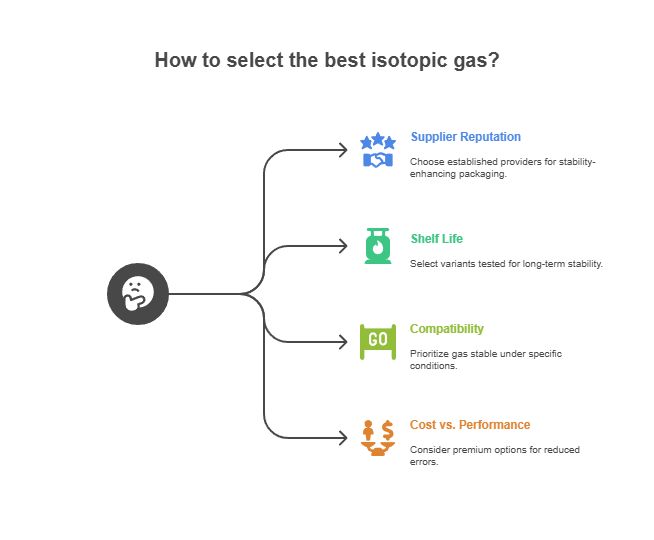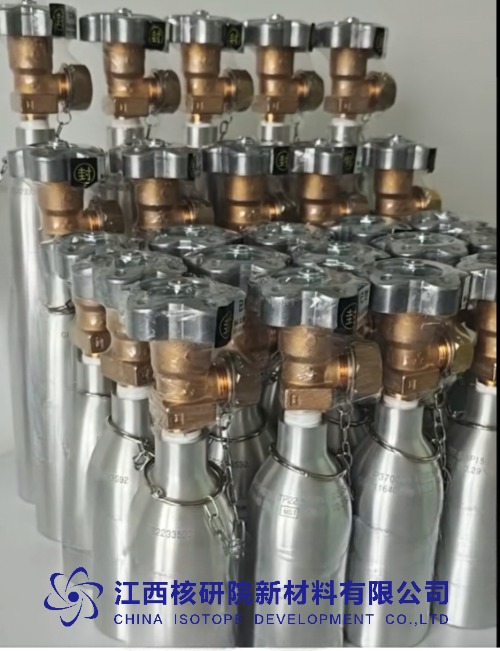How to Select High-Stability Carbon-13 Dioxide (¹³CO₂) Gas?
BY Tao, Published Aug 18, 2025
1. Understanding Stability in ¹³CO₂ Gas
Carbon-13 dioxide, or ¹³CO₂, is a specialized isotopic form of carbon dioxide where the carbon atom is predominantly the stable carbon-13 isotope. This gas plays a critical role in applications ranging from medical diagnostics to environmental tracing, owing to its non-radioactive properties and precise isotopic signature. Stability in ¹³CO₂ refers not just to chemical inertness but also to the maintenance of isotopic purity over time, resistance to degradation, and consistent performance under varying conditions. In my extensive experience researching gas isotopes and carbon-oxygen compounds, I’ve seen how instability—such as isotopic fractionation or impurity ingress—can compromise experimental accuracy or industrial processes.
High-stability ¹³CO₂ is essential because even minor fluctuations in isotopic ratio (¹³C/¹²C) can skew results in sensitive analyses like isotope ratio mass spectrometry (IRMS) or cavity ring-down spectroscopy (CRDS). Factors influencing stability include production methods, storage conditions, and handling practices. For instance, ¹³CO₂ derived from cryogenic distillation tends to exhibit superior long-term stability compared to chemically converted variants, as it minimizes exposure to reactive intermediates. Selecting high-stability ¹³CO₂ involves evaluating these aspects to ensure the gas retains its integrity, whether for breath tests in clinical settings or carbon cycle studies in atmospheric science.
2. Key Factors for Selecting High-Stability ¹³CO₂
Choosing the right ¹³CO₂ gas demands a methodical approach, balancing isotopic enrichment, purity levels, and supplier reliability. Over decades in the nuclear elements field, I’ve advised on selections that prioritize stability to avoid costly rework in research or production.
First, assess isotopic enrichment: Aim for at least 99% ¹³C abundance to minimize interference from ¹²C, which is crucial for applications like metabolic tracing where precise δ¹³C measurements are required. Lower enrichments can lead to signal dilution, reducing stability in analytical outputs.
Second, evaluate chemical purity: High-stability ¹³CO₂ should exceed 99.9% purity, with impurities like water vapor, oxygen, or nitrogen capped at parts-per-million levels. These contaminants can catalyze unwanted reactions, such as oxidation, degrading the gas over time.
Third, consider production and certification: Opt for gas produced via methods like laser isotope separation or advanced distillation, which offer better control over stability. Look for certified reference materials (CRMs) that undergo rigorous metrological traceability, ensuring consistent δ¹³C values.
Additional factors include:

By weighing these, you can secure ¹³CO₂ that maintains its high-stability profile throughout its lifecycle.
3. Product Specifications and Parameters
High-stability ¹³CO₂ gas comes with detailed specifications that define its quality and suitability. These parameters are derived from industry standards, ensuring the gas meets demands in rare gas and isotopic applications. Typically supplied in seamless steel or aluminum cylinders, ¹³CO₂ is characterized by its isotopic and chemical attributes.
A comprehensive overview of typical specifications includes:
| Parameter | Typical Value | Description |
|---|---|---|
| Isotopic Enrichment | ≥99 atom % ¹³C | Ensures high ¹³C/¹²C ratio for accurate tracing without dilution effects. |
| Chemical Purity | ≥99.999% | Limits impurities to <10 ppm, enhancing chemical stability and preventing reactions. |
| Molecular Weight | ~45 g/mol | Reflects the heavier isotope, influencing diffusion and separation behaviors. |
| Pressure Range | 5-20 bar at 21°C | Standard filling pressures for safe transport and use in cylinders. |
| Volume Options | 1-50 liters | Scalable from lab-scale lecture bottles to industrial cylinders. |
| Impurity Limits | H₂O <5 ppm, O₂ <2 ppm, N₂ <5 ppm | Critical for maintaining stability, as moisture can lead to hydrolysis. |
| Certification | IRMS-verified δ¹³C | Provides traceable stability data, often with uncertainty <0.1‰. |
These specs are optimized for high-stability performance, with suppliers often providing mass spectrometry certificates to confirm parameters. For instance, in fluorocarbon-integrated processes, low oxygen content is vital to avoid oxidative instability.
4. Performance Evaluation of High-Stability ¹³CO₂
Evaluating the performance of ¹³CO₂ gas focuses on its reliability in real-world scenarios, where stability translates to consistent isotopic ratios and minimal degradation. In my work with carbon-oxygen gases, I’ve tested numerous batches, finding that high-stability variants excel in metrics like long-term isotopic integrity and resistance to environmental stressors.
Key performance characteristics include superior sensitivity in detection methods, such as achieving parts-per-billion traceability in CRDS for atmospheric studies. The gas’s stability allows for extended shelf life—often indefinite when stored properly—without significant shifts in δ¹³C, which is essential for calibrated reference standards.
In practical terms, high-stability ¹³CO₂ demonstrates:
- Thermal Resilience: Maintains integrity from -50°C to +50°C, ideal for transport in varying climates.
- Chemical Inertness: Resists fractionation during mixing with other gases, supporting applications in mixed isotopic studies.
- Analytical Precision: Yields high signal-to-noise ratios in NMR or IRMS, with variability <0.05‰ over repeated measurements.
- Durability in Use: Withstands high-pressure handling without impurity ingress, crucial for industrial scaling.
To assess performance, conduct stability tests like periodic IRMS sampling post-storage. This ensures the selected ¹³CO₂ delivers reliable results, whether in biofuel tracing or medical breath analysis.
5. Usage Considerations and Best Practices
Handling high-stability ¹³CO₂ requires adherence to protocols that preserve its integrity, drawing from safety standards in compressed gas management. As an expert in special gases, I emphasize preventive measures to avoid contamination or pressure-related issues.
Store cylinders upright in well-ventilated areas, secured with chains or racks to prevent tipping, and away from heat sources or incompatible materials like strong oxidizers. Maintain temperatures between 15-25°C to minimize thermal expansion risks. Use regulators designed for CO₂ to control flow precisely, avoiding over-pressurization that could introduce air impurities.
Best practices include:
- Personal Protective Equipment: Wear gloves, safety glasses, and respiratory protection in confined spaces to guard against asphyxiation, as ¹³CO₂ displaces oxygen.
- Leak Detection: Regularly inspect valves and connections with soap solutions or electronic detectors, responding immediately to any anomalies.
- Emergency Protocols: Have CO₂ monitors on-site and emergency plans for leaks, including evacuation and ventilation procedures.
- Transport Guidelines: Use approved carriers with cylinders capped and labeled, complying with hazardous materials regulations.
- Disposal: Depressurize and recycle empty cylinders through certified facilities to prevent environmental release.
These steps ensure the gas’s high-stability is maintained, reducing risks in applications involving rare metals or neon-based materials.
6. Advancements and Future Considerations
The landscape for selecting high-stability ¹³CO₂ is evolving with technological strides, such as improved laser separation for even higher enrichments and AI-driven quality controls for predictive stability. By 2025, expect enhanced CRMs with tighter uncertainty margins, driven by demands in carbon capture and sustainable energy tracing. Staying informed on these trends will refine selection processes, ensuring ¹³CO₂ continues to support innovative nuclear element research.
Would you like a deeper dive into any specific applications (e.g., cancer diagnostics, microbiome research)?
(Follow our update on www.asiaisotopeintl.com or contact tao.hu@asiaisotope.com for more information or call us for a in-time communications.)







